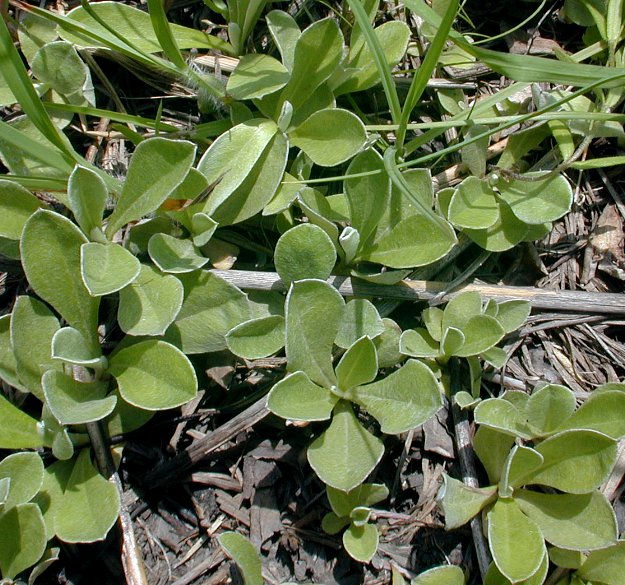Description: This perennial herbaceous plant is up to 1' tall, but more commonly ½' or less. It consists of a rosette of basal leaves, which sometimes produces an inflorescence on a short stalk during the spring. The basal leaves are up to 2" long and ½" across; they are oblanceolate, with smooth margins. There is a single prominent vein on the upper surface of each basal leaf, while the lower surface is white and hairy. There are small alternate leaves along the pubescent flowering stalk; they are narrowly lanceolate or linear.

At the top of each
stalk, a plant produces a few flowerheads about 1/3" (8 mm.) long that
are
either staminate or pistillate. These flowerheads resemble compact
tufts of white hair. The blooming period occurs from mid- to late
spring and lasts about 3 weeks. There is no noticeable floral scent.
The flowerheads are quickly replaced by achenes with small tufts of
white hair, which are distributed by the wind. Field Pussytoes spread
by means of horizontal stolons that are hairy and have small alternate
leaves that are narrowly lanceolate or linear. These stolons develop
plantlets that root in the ground, and resemble the mother plant. The
root system consists of a central taproot. This plant often forms small
colonies.
Cultivation:
The preference is partial or full sun, and mesic to dry conditions.
This plant flourishes in soil that is rocky or contains clay; it also
grows readily in fertile loam. Most of the growth and development
occurs during the spring, before pests and disease become troublesome.
Range & Habitat:
The native Field Pussytoes occurs occasionally in northern and central
Illinois;
it is less common in southern Illinois (see Distribution
Map). Habitats include mesic to dry black soil prairies, clay
prairies, slopes of open woodlands, dry meadows in woodland areas,
savannas, shale glades, eroded clay banks, pastures, abandoned fields,
and roadsides. This plant is allelopathic, and tends to reduce the
height of neighboring grasses and forbs. It is more commonly found in
prairies than Antennaria plantaginifolia
(Plantain-leaved Pussytoes.

Faunal Associations: Some authorities state that this is primarily a wind-pollinated plant, while others emphasize the role of insects in promoting cross-pollination. Primarily small bees and flies visit the flowers, including Halictid bees, Andrenid bees, cuckoo bees (Nomada spp., Sphecodes spp.), Syrphid flies, Muscid flies, Calliphorid flies, and Tachinid flies (Graenicher, 1909). The caterpillars of a butterfly, Vanessa virginiensis (American Painted Lady), feed on the foliage (Bouseman & Sternburg, 2001). Other insect feeders that feed on the foliage and other parts of Field Pussytoes and other Antennaria spp. include the gall-forming larvae of two flies, Asphondylia antennariae (Everlasting Bud Midge) and Rhopalomyia antennariae, larvae of a moth, Tebenna gnaphaliella (Everlasting Tebenna Moth), a plant bug (Melanotrichus catulus), and an aphid (Pleotrichophorus antennarius); see Felt (1917), Needham et al. (1928), Wheeler et al. (1983), and Blackman & Eastop (2013). Among vertebrate animals, some upland gamebirds feed on the foliage and/or seedheads, including the Ruffed Grouse, Bobwhite Quail, and Greater Prairie Chicken; White-tailed Deer also feed on these plants, especially during the spring (Martin et al., 1951/1961; Korschgen, 1962).

Photographic
Location:
The photograph of the colony of blooming plants (both staminate
& pistillate) was taken along a roadside
in Vermilion County; the photograph of the basal leaves was
taken at Prospect Cemetery Prairie in Ford County, Illinois; the
photograph of of the blooming pistillate plants was taken at an upland
savanna of the Champaign County Forest Preserve in Champaign County,
Illinois.
Comments:
Field Pussytoes is similar to Antennaria plantaginifolia
(Plantain-Leaved Pussytoes), but the latter has wider basal leaves with
3 prominent parallel veins. These are both cute-looking little plants
that could
be grown in rock gardens; they are particularly attractive while
blooming during the spring.